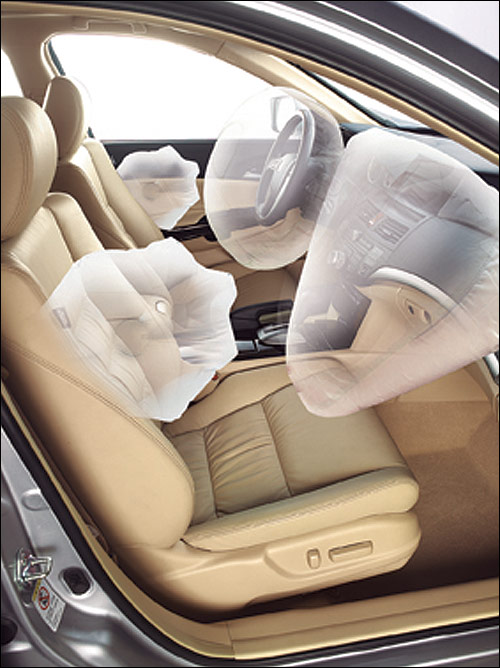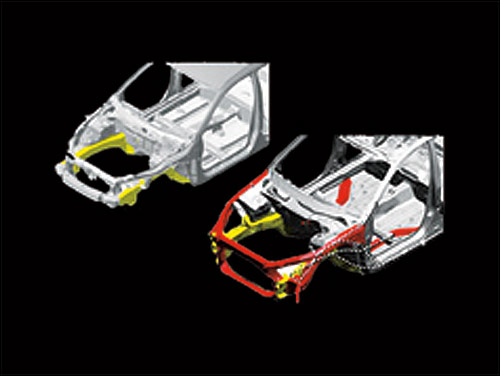An in-depth analysis of why the strongest Accord is safe.
In the recent C-NCAP test, the eighth generation Accord got a 5+ star rating with a score of 50.3, making it the only car model that got a 5+ rating among all the tested car models. In terms of safety alone, the Eight-Generation Accord really deserves the title of "the strongest in history". So how did the Accord achieve such good results? Besides the C-NCAP test project, how does the Accord perform in other safety projects? This article will take you to know more about the safety of the Accord.
 | |
ACE body design based on G-CON
From the scene of C-NCAP collision, it can be seen that the eighth generation Accord can ensure that the passenger compartment is intact, the airbag triggering time is accurate, and the dummy has no obvious displacement, regardless of the frontal collision of 100%, frontal collision of 40% or side collision, showing a very high safety level. The achievement of this effect is mainly due to the "Advanced Compatibility Design (ACE)" body structure technology which was innovated on the basis of G-CON technology for the first time adopted by the Eighth Accord.
G-CON vehicle impact control technology is a high-level all-round collision safety technology developed by Honda.
By controlling the impact force G to the car body, the impact force G to the passengers and the impact force G to the pedestrians when a collision occurs, the injury to people can be reduced, which is a general term of safety technology to ensure the safety of the passengers in the car and give consideration to the safety of pedestrians. Honda CR-V, Odyssey and other models have achieved good results in C-NCAP test by virtue of G-CON technology. The eighth generation Accord also adopted G-CON technology, and further adopted ACE advanced compatible body design.
With the help of an advanced computer-aided design process, a fully integrated load-bearing unit network is constructed, which can distribute the collision force evenly to a larger area in front of the vehicle, reduce the peak collision force, enable the Accord to absorb the collision energy efficiently, and minimize the occurrence of upper or lower overlap when it collides with an oversized or undersized vehicle.
In the conventional design of the car body, the frontal collision energy is transmitted to the lower load-bearing structure at the front end of the vehicle, while the ACE system can effectively channel the frontal collision energy to the upper and lower structural members at the same time, including the floor longitudinal beam, the side sill and the A-pillar. ACE system can distribute these frontal collision forces in a larger proportion of the total vehicle structure by establishing a clear engineering structure "path", so as to avoid the collision forces more effectively, reduce the deformation of the passenger compartment and further improve the protection ability for passengers.
The floor design of the eighth generation Accord can better disperse and absorb energy and improve the protection ability. The main longitudinal beam positioned on the floor further improves the vehicle’s ability to withstand severe side impact. At the same time, the rear rigidity of the car body is improved through the new and stronger rear structural parts.
The dosage of 590 high strength steel plate is increased by 3 times.
In the crash test, all the items of the Eighth Accord got almost full marks, and the high-rigidity car body structure also contributed. The eighth generation Accord has comprehensively improved the usage of high-strength steel plates in the body frame, from 13% in the previous generation to 48%, especially the usage of No.590 steel has increased three times compared with the past, accounting for 42%, which is mainly used in the passenger compartment. Therefore, the torsional stiffness of the whole vehicle is increased by 20%, the vertical stiffness of the rear part is increased by 33%, and the support point stiffness of the front suspension is increased by 36%. The extensive use of high-strength steel plates and the application of crash-proof steel beams as standard configuration have completely broken through the rigidity level of existing European cars and set a new standard for car body safety performance.
 | |
6 Airbags provide all-round protection for passengers.
Airbags play an important role in modern automobile safety design. Honda began to develop airbags as early as 1971, putting "people" as the first consideration. The eighth generation Accord is equipped with an all-round airbag system, which can effectively ensure the safety of the occupants in the car, mainly including intelligent front airbags, front seat side airbags and side airbags.
The eighth generation Accord’s main and passenger seats are equipped with advanced intelligent frontal airbags, which can quickly sense and judge according to the collision state. Two-stage detonators are adopted, and two-stage explosions are carried out according to the collision degree to control the start of airbags, optimize the speed of airbag deployment, and minimize the impact of airbag deployment on passengers.
When a side collision occurs, the front seat side airbag can block the front window to prevent the occupant from colliding with the door and pillar. When used in conjunction with airbags, front seat side airbags will play a higher degree of protection. The intelligent side airbag and airbag curtain system can provide effective protection for passengers in the event of side collision.
The Eighth Accord also has an intelligent OPDS (Occupant Posture Detection System) occupant attitude detection system, which controls the deployment state of the side airbag by sensing the sitting height and head position of the co-pilot occupant through sensors inside the seat, thus protecting the occupant’s safety to the greatest extent.
The newly designed safety air curtain can provide better head protection for the front passengers and the outer passengers in the rear when a side collision occurs.
Bidirectional pretensioned seat belt
By analyzing the C-NCAP test results of Accord, one of the items that attracted the author’s special attention was that Accord got full marks in the chest index in the frontal 00% collision. This indicator has always been the weakness of domestic and foreign models in NCAP testing. Among the tested models of C-NCAP, Accord is the only one that gets full marks in this indicator. Apart from the advanced body design and the optimization of restraint system, the Accord’s seat belt system is also worth mentioning. The front seat of the Eighth Accord adopts a two-way pre-tightening device and a seat belt system with a load limiter, which further improves the restraint effect on the driver and reduces the degree of injury.
active head restraint
When a rear-end collision occurs, the neck of the passenger will be subjected to a large impact force, which is very easy to be injured. The eighth generation Accord is equipped with a front seat active safety headrest, which reduces the injury to the neck in the event of a rear collision. In the event of a rear collision, the occupant is pushed to the seat back, and a linkage mechanism in the seat back will press the lower end of the rear headrest connecting rod, so that the headrest moves forward to support the head and reduce the impact on the passenger’s head, neck and spine.
Six in one active safety system
In addition to the leading passive safety technology, the Eighth Accord is equipped with a complete six-in-one active electronic security systems, including anti-lock braking system (ABS), electronic braking force distribution system (EBD), brake assist system (BA), traction control system (TCS/ASR), sideslip control system (SC) and vehicle stability assistance system (VSA).
 | |
Reduce the injury to pedestrians
Guangzhou Honda has always regarded "safety for all" as its core concept. The eighth generation Accord not only provides the strongest protection performance for the occupants in the car, but also makes a special design for pedestrian safety. Usually, when a collision happens, the most vulnerable parts for pedestrians are the head and the front of the body. The eighth generation Accord has adopted a carefully considered energy-absorbing design for pedestrian protection headstock. The height of the engine cover, the softness of the metal and the distance between it and the hard engine cover have been carefully calculated, designed into a deformation mode that can cushion the impact force, and adopted materials that can absorb the impact energy. When a collision occurs, it can buffer the impact force and minimize the damage to pedestrians.
Outstanding test results
The eighth generation Accord not only achieved excellent results of 5+ stars in the C-NCAP collision in China, but also got the highest evaluation from G in the collision test of IIHS, an American safety collision testing institution. In the US-NCAP crash test, the eighth generation Accord also got the highest evaluation of 5 stars, reaching the best safety performance in its class. The excellent collision results of the eighth generation Accord around the world fully prove its safety level beyond national boundaries.
Design concept focusing on the real world
The development concept of the eighth generation Accord is to provide drivers and passengers with a pleasant driving experience that they can feel personally, which also includes reliable safety guarantee. Honda is not satisfied with the safety research at the theoretical level, but focuses on the study of real scenes in the real world, making vehicles more in line with the safety requirements under actual road conditions. For this reason, Honda built the world’s first indoor omni-directional collision test facility in 2000. Through the statistics and analysis of real traffic accident data in various countries, it can simulate the real-world collision scene and study the safety technology that is more in line with the real world. It is under this design concept that the eighth generation Accord has repeatedly verified the high-strength and high-precision safety car body design by simulating real-world collision tests and driving tests on the test track, so as to deal with complex and diverse collision situations in the real world with full safety guarantee.
(Source: World Auto)